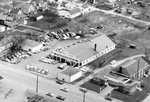Keywords: kindness
Item 5486
Rebecca Usher account of Abraham Lincoln visit, Virginia, ca. 1870
Contributed by: Maine Historical Society Date: 1865 Location: City Point; Hollis Center Media: Paper
Item 6190
Rosemary Cottage, Eliot, ca. 1888
Contributed by: Eliot Baha'i Archives Date: circa 1888 Location: Eliot Media: Photographic print
Item 37310
158 Commercial Street, Portland, 1924
Owner in 1924: James H McDonald Use: Store & Storage
Item 151218
Burmeister residence, Paris, 1981-1996
Contributed by: Maine Historical Society
Date: 1981–1996
Location: Paris; Paris
Clients: William Burmeister; Cynthia Burmeister
Architect: Patrick Chasse; Landscape Design Associates
This record contains 6 images.
Exhibit
Maine's Untold Vegetarian History
Vegetarianism has deep roots in Maine and this first-of-its-kind exhibition explores this untold story.
Exhibit
Maine and the Civil War - Togus Veterans' Hospital view, 1885
"This facility was the first of its kind established to serve disabled veterans after the Civil War. Today, one of the buildings is on the National…"
Site Page
Farmington: Franklin County's Shiretown - Farmington's First Grist Mill
"… be milled into flour, which greatly increased the kinds of food the settlers ate, as well as allowed them to store the flour for later use."
Site Page
Presque Isle: The Star City - Carroll's Auto Sales Buildings
"At first, Skippy sold all kinds of used cars and trucks. A few years later, he purchased the Brewer Chevrolet franchise and facilities in 1961."
Story
We Are An Ordinary Family
by Catherine
Maine's abolitionists offer an answer to my questions about my family's experiences.
Story
Beef Cutlet always reminds me of home in Iran
by Parivash Rohani
Making beef cutlet in Maine connects me to my home in Iran and my Baha'i faith.
Lesson Plan
Longfellow Studies: "The Jewish Cemetery at Newport"
Grade Level: 6-8, 9-12
Content Area: English Language Arts, Social Studies
Longfellow's poem "The Jewish Cemetery at Newport" opens up the issue of the earliest history of the Jews in America, and the significant roles they played as businessmen and later benefactors to the greater community. The history of the building itself is notable in terms of early American architecture, its having been designed, apparently gratis, by the most noted architect of the day. Furthermore, the poem traces the history of Newport as kind of a microcosm of New England commercial cities before the industrialization boom. For almost any age student the poem could be used to open up interest in local cemeteries, which are almost always a wealth of curiousities and history. Longfellow and his friends enjoyed exploring cemeteries, and today our little local cemeteries can be used to teach little local histories and parts of the big picture as well.
Henry Wadsworth Longfellow visited the Jewish cemetery in Newport, RI on July 9, 1852. His popular poem about the site, published two years later, was certainly a sympathetic portrayal of the place and its people. In addition to Victorian romantic musings about the "Hebrews in their graves," Longfellow includes in this poem references to the historic persecution of the Jews, as well as very specific references to their religious practices.
Since the cemetery and the nearby synagogue were restored and protected with an infusion of funding just a couple years after Longfellow's visit, and later a congregation again assembled, his gloomy predictions about the place proved false (never mind the conclusion of the poem, "And the dead nations never rise again!"). Nevertheless, it is a fascinating poem, and an interesting window into the history of the nation's oldest extant synagogue.














